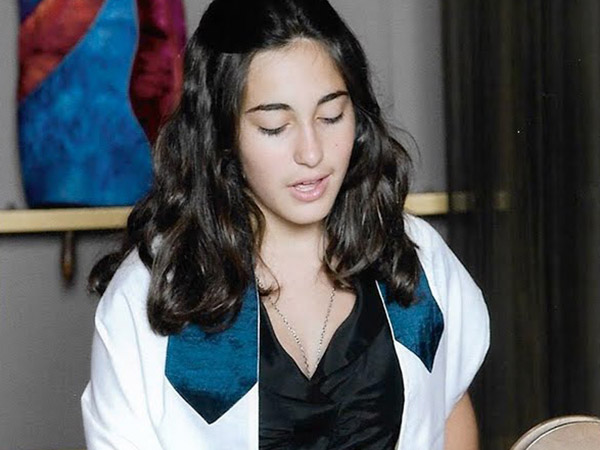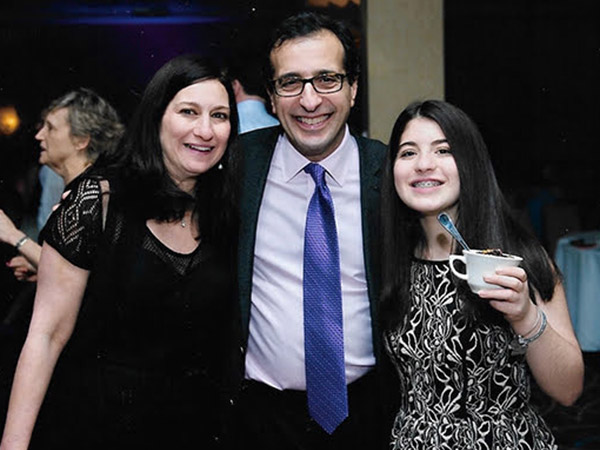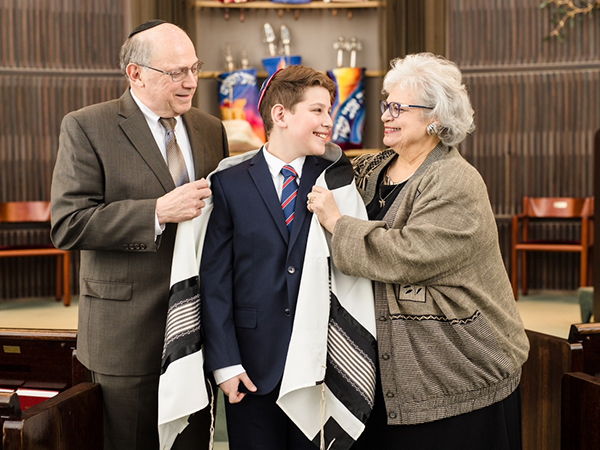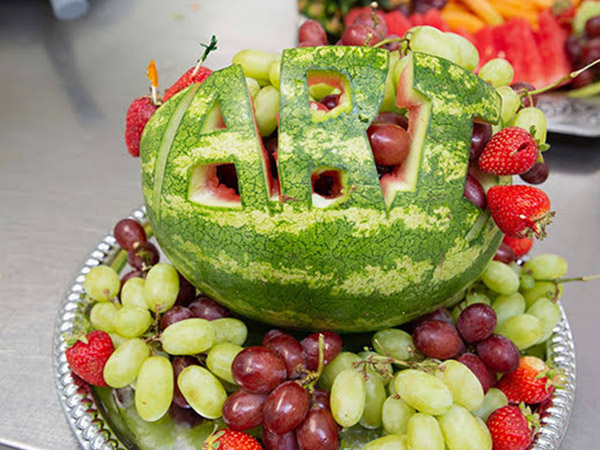CELEBRATING A BAR/BAT MITZVAH
Hosting the Simcha
The most essential aspect of becoming a Bar/Bat Mitzvah is the child’s spiritual step forward to assume his/her role and responsibilities as a Jewish adult. The community’s welcoming of the Bar/Bat Mitzvah as a Jewish adult is also important, and for that reason it is our custom for the family to host the congregation at a celebratory meal, the Kiddush, immediately following the service.
Also, following the Friday morning minyan prior to the Bar/Bat Mitzvah — in which the student will lead parts of the service and deliver a D’var Torah — a hot breakfast is served during the school year. Typically, the Bar/Bat Mitzvah family will sponsor the breakfast.
Have more questions? Of course you do. You’ll find all (or almost all) the answers and a ton of other important stuff in our extensive Bar/Bat Mitzvah Handbook.
Parties or Other Celebrations
Any celebration in addition to the Kiddush is “icing on the cake” — your child’s step forward into Jewish adulthood is what truly matters. There is no pressure to host a party beyond a Kiddush lunch. However, if you choose to have a party or other celebration, you may wish to consider:
- Saturday evening party (beginning with Havdalah or one hour after sundown)
- Party anytime on Sunday
- Sunday brunch for family and friends
- Friday night dinner for family and out-of-town guests
- Afternoon luncheon following Kiddush
- Family trip to Israel
Cell Phones & Photography
Please be sure your guests are aware that using cell phones or cameras is strictly prohibited on Shabbat (including Friday night) anywhere on synagogue property, in order to preserve the holiness that is present.
To schedule a formal photography session in the sanctuary, please contact the office at least two weeks in advance.
But wait, there’s more. Lots more.
Have more questions? Of course you do. You’ll find all (or almost all) the answers and a ton of other important stuff in our extensive Bar/Bat Mitzvah Handbook. For anything and everything else, feel free to contact the office anytime. We’re here to help.
What To Expect
Bar (for a boy), Bat (for a girl), or B’nai (plural) Mitzvah means “one who is obligated by the commandments.”
Becoming a Bar Mitzvah (for a boy) or Bat Mitzvah (for a girl) is when a Jewish youth becomes responsible for following the commandments and commitments of a Jewish adult, and is accepted as a participating member and occasional leader of the service.
Wearing a head covering: A kippah (called a yarmulke in Yiddish) is worn by males during the service and also by women in some synagogues. Wearing a head covering is not a symbol of religious identification, but is rather an act of respect to G-d and the sacredness of the worship space. Just as men and women may be asked to remove their hats in the church, or remove their shoes before entering a mosque, covering the head is a non-denominational act of showing respect.
Wearing a prayer shawl: The tallit, or prayer shawl, is traditionally worn by Jewish men and, in some congregations including ours, by Jewish women. Because the braided fringes at the tallit’s corners remind its wearer to observe the commandments of Judaism, wearing a tallit is reserved for Jews. Although an usher may offer you a tallit at the door, you may decline it if you wish.
Maintaining sanctity: All guests and participants are expected to respect the sanctity of the prayer service and Shabbat by setting your cell phone to vibrate or turning it off and not taking pictures or video.
Sitting and standing: Jewish worship services can be very athletic, filled with frequent directions to stand for particular prayers and sit for others. Take your cue from the other worshipers or the rabbi’s instructions. Unlike kneeling in a Catholic service, which is filled with religious significance, standing and sitting in a Jewish service does not constitute any affirmation of religious belief; it is merely a sign of respect.
Following the service: Try to follow the service in the siddur (prayer book) and the weekly reading in the Humash (Torah book), both of which are usually printed in both Hebrew and English. Guests and congregants are encouraged to hum along during congregational melodies and to participate in the service to the extent that they feel comfortable.
Special note regarding young children:
The presence of children in the sanctuary is a gift to our community, and we welcome them with the understanding that they will make noise from time to time. During services, it is not unusual to see little ones making their way up the aisles or up the steps of the bimah to say “hi” to the Rabbi. Don’t worry – we all think it’s cute! Although we love kids, if your child is noisy during the Rabbi’s sermon or the silent Amidah, or is being disturbingly noisy, we do ask that you relocate to the hallway or a quiet room.
If you feel unsure what to do, please ask someone. We will be happy to help you, whatever the question.
Sanctuary Etiquette
We hope your visit to Beth El is an uplifting and joyous experience. To help us all maintain the sanctity of the synagogue and this wonderful occasion, we would appreciate your cooperation with the following:
- Services do start on time at Beth El. Do not plan on arriving late for a Bar/Bat Mitzvah, or you may miss the big moment!
- A Shabbat service involves a lot of standing and sitting… and standing and sitting. Whenever the curtain of the Ark is opened to reveal the Torah, for example, the congregation stands until the curtain is closed. An announcement will be made whenever standing is required.
- If necessary, it is acceptable to quietly go in and out of the sanctuary, except during a few parts of the service, when the ushers will keep the doors closed. These include:
- When the Ark is open
- During a reading from the Torah (you’ll see the scroll open on the center table)
- During the Haftorah (the Bar/Bat Mitzvah is chanting alone)
- During a D’var Torah (sermon or speech) and other presentations
- During the Mourner’s Kaddish (a number of people throughout the sanctuary will be standing with their heads bowed)
- During the Amidah (everyone is standing and reading silently)
- Jewish law strictly prohibits photography, writing, drawing, and the use of electronics on Shabbat (including both Friday night and all Saturday). Please turn off all cell phones and electronic devices while on synagogue property.
- Additionally, smoking is not permitted on synagogue grounds at any time.
- Please keep conversations to a minimum. We know that services are a time to connect with friends and family – but try to wait for the Kiddush meal!
- Speaking of noshing, only Kosher food may be brought into the synagogue.
- Most of all, enjoy being with us! If you feel unsure what to do, ask someone – we will be happy to help you, no matter what the question.
If you feel unsure what to do, please ask someone. We will be happy to help you, whatever the question.
What To Wear
Appropriate, modest dress by adults, teens, and all others is expected.
1. Girls and women are requested to wear a modest dress, skirt, or slacks, with an appropriate shirt or blouse. We require shoulders and midriff to be fully covered.
2. Boys and men are expected to wear a collared shirt & tie, and slacks or khakis. Those called to the bimah should wear a suit or sport jacket.
3. Jeans, shorts, micro-skirts, and tee shirts are not permitted.
4. Every male, including non-Jews, must wear a kippah during services, and women are welcome and encouraged to do so. In our tradition, covering one’s head is a sign of our recognition that there is Someone “above” us who watches our every act. Kippahs are provided for you to keep as a souvenir, and for when you visit us again.
5. We encourage every Jewish man and woman, over the age of Bar/Bat Mitzvah, to wear a Tallit (prayer shawl) during services. A Tallit is required when reading, carrying, or holding the Torah. Tallitot are available for those who have not brought one.






